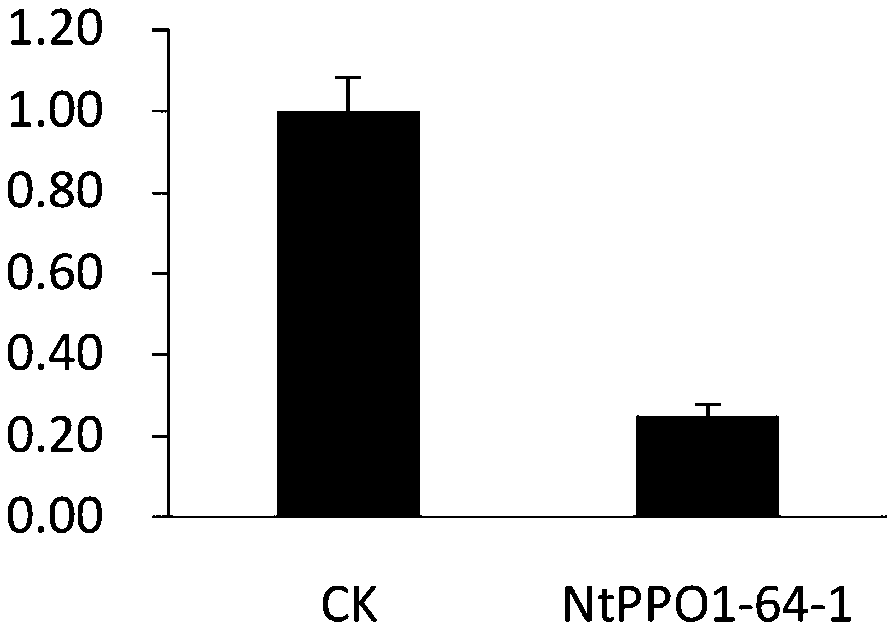Tobacco polyphenol oxidase gene NtPPO1 and site-directed mutagenesis method and application thereof
A polyphenol oxidase and site-directed mutagenesis technology, applied in the field of genetic engineering, can solve the problems of reducing the aroma components of tobacco leaves, decreasing the appearance and internal quality of tobacco leaves, and economic losses.
- Summary
- Abstract
- Description
- Claims
- Application Information
AI Technical Summary
Problems solved by technology
Method used
Image
Examples
Embodiment 1
[0101] Using the above method, a transgenic NtPPO1 gene NtPPO1-64 was obtained by sequencing. The results after sequencing are compared with the reference sequence as follows figure 1 .shown. The arrow mark shows that after the NtPPO1 gene is at the sgRNA target site, there are double peaks in the sequencing map, indicating that the sequence of the NtPPO1 gene has changed this time.
[0102] The transgenic plant NtPPO1-64 was harvested after selfing, and the NtPPO1 gene of the selfed offspring NtPPO1-64-1 was found to appear as follows figure 2 . Mutations indicated. After the target sgRNA sequence, the NtPPO1 gene is missing -2bp (missing 2 GG bases), resulting in a change in the gene reading frame. After the knockout site of the NtPPO1 gene, the translated protein sequence changed, and finally a TAA stop codon appeared in advance at the original 112th codon that started encoding the amino acid Lys protein, resulting in early termination of translation.
[0103] Determin...
Embodiment 2
[0106] Using the above method, a transgenic NtPPO1 gene NtPPO1-70 was obtained by sequencing. The results after sequencing are compared with the reference sequence as follows Figure 5 .shown. The arrow mark shows that after the NtPPO1 gene is at the sgRNA target site, there are double peaks in the sequencing map, indicating that the sequence of the NtPPO1 gene has changed this time.
[0107] The transgenic plant NtPPO1-70 was harvested after selfing, and it was found by sequencing that the NtPPO1 gene of the selfed offspring NtPPO1-70-1 appeared as follows: Image 6 . Mutations indicated. After the target sgRNA sequence, the NtPPO1 gene is missing -1bp (missing 1 G base), resulting in a change in the gene reading frame. After the knockout site of the NtPPO1 gene, the translated protein sequence changed, and finally a TAA stop codon appeared at the original 193rd start coding amino acid Leu codon frame shift, resulting in premature termination of translation.
[0108] Dete...
Embodiment 3
[0111] Using the above method, a transgenic NtPPO1 gene NtPPO1-72 was obtained by sequencing. The results after sequencing are compared with the reference sequence as follows Figure 9 .shown. The arrow mark shows that after the NtPPO1 gene is at the sgRNA target site, there are double peaks in the sequencing map, indicating that the sequence of the NtPPO1 gene has changed this time.
[0112] The transgenic plant NtPPO1-72 was harvested after selfing, and it was found by sequencing that the NtPPO1 gene of the selfed offspring NtPPO1-72-1 appeared as follows: Figure 10 . Mutations indicated. After the target sgRNA sequence, the NtPPO1 gene inserted +1bp (inserted 1 A base), resulting in a change in the gene reading frame. After the NtPPO1 gene was knocked out, the translated protein sequence changed, and finally a TAA stop codon appeared at the codon of the original 112th start coding amino acid Lys, resulting in premature termination of translation.
[0113] Determination...
PUM
 Login to View More
Login to View More Abstract
Description
Claims
Application Information
 Login to View More
Login to View More - R&D
- Intellectual Property
- Life Sciences
- Materials
- Tech Scout
- Unparalleled Data Quality
- Higher Quality Content
- 60% Fewer Hallucinations
Browse by: Latest US Patents, China's latest patents, Technical Efficacy Thesaurus, Application Domain, Technology Topic, Popular Technical Reports.
© 2025 PatSnap. All rights reserved.Legal|Privacy policy|Modern Slavery Act Transparency Statement|Sitemap|About US| Contact US: help@patsnap.com



